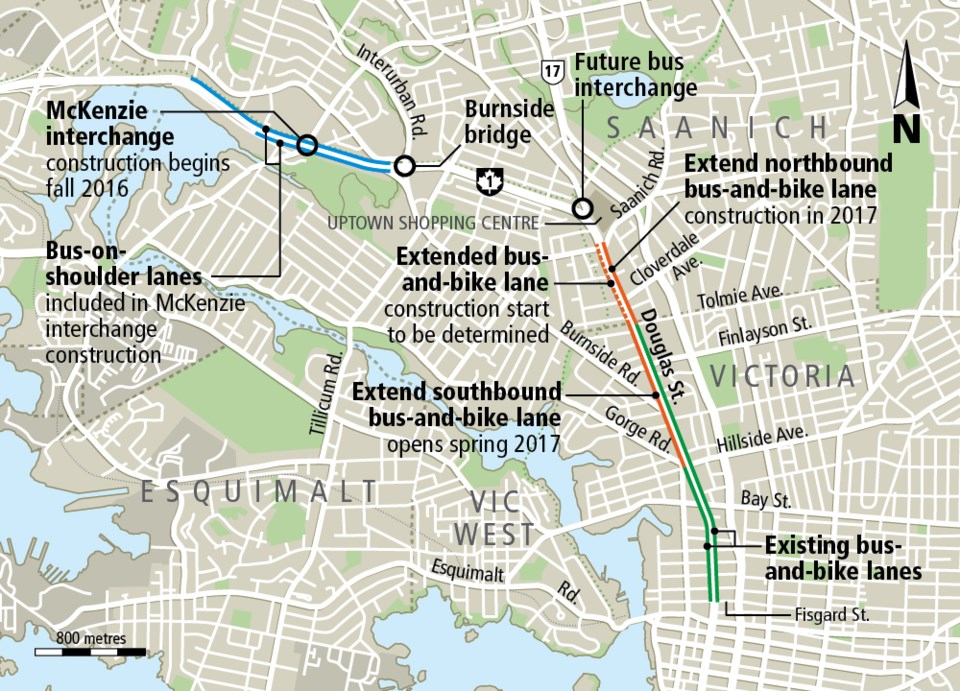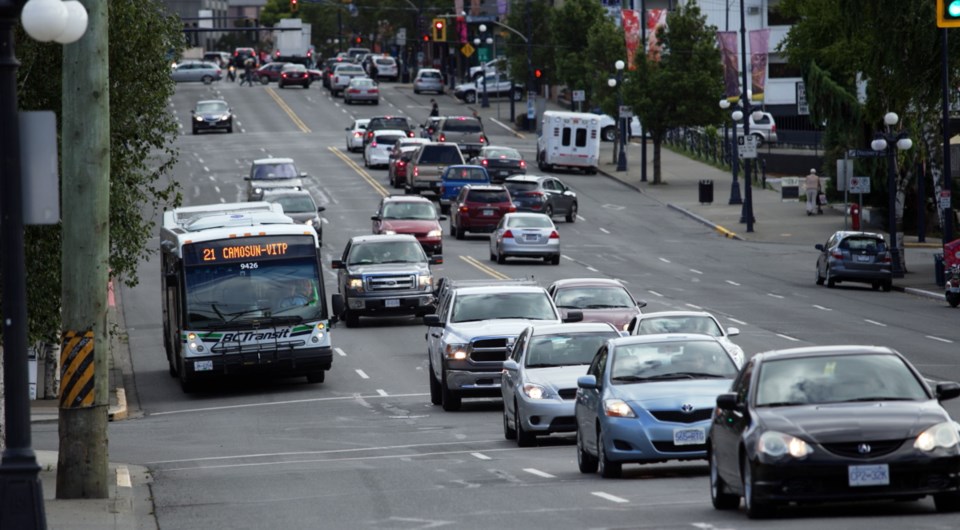Here’s a problem: After two years and coming up on $3 million, the Douglas Street bus lanes are clogged with cars — and police say there’s little they can do about it.
On any given weekday, the curb lanes meant to send buses and bikes whooshing past the rest of the rush (ha!) hour traffic are slowed by cars that aren’t supposed to be there. It’s particularly bad during the afternoon exodus from downtown.
“It happens every day,” said East Sooke’s Mike Kelley, who has spent 25 years riding B.C. Transit to work in Victoria. Bus drivers who used to occasionally honk at the rule-breakers now just seem resigned to the congestion. Passengers merely look at one another and shrug.
Yet when Kelley complained to Victoria police this spring, he was told inadequate signage makes the bus lane law hard to enforce.
Road markings have become faded and hard to read, he was told. Signs sometimes fail to make the bus-lane rules obvious to drivers turning onto Douglas from feeder streets. “From a traffic enforcement perspective, we must ensure that every ticket we write will provide a substantial likelihood of conviction,” VicPD wrote in an email to Kelley. “The current signage and road markings do not allow for that.
“We too would like to see these bus/bicycle lanes used in a way in which they were intended,” the email stated, going on to say that dialogue with the city would continue.
For the record, here’s what the law says: The priority lanes are in effect 6 to 9 a.m. southbound and 3 to 6 p.m. northbound. During those times, only buses and (brave/suicidal) cyclists may use them. Other vehicles may be in the lanes only to make right turns. The rule of thumb used by police is that a driver travelling more than a block without turning is breaking the law.
Most people comply with the rules, but there are enough motorists driving — or parking — in the priority lanes that it defeats their purpose.
“We do hear frustration from bus drivers and customers when there are private vehicles in the bus lanes, as it interferes with their planned route,” B.C. Transit said.
Transit also said that based on feedback from police, it has joined with the city in improving signage and will continue to do so. Police, though, say they don’t feel they can do much enforcement as things stand.
Kelley said he applauded in 2014 when the City of Victoria backed the priority-lane idea as a means of unplugging roads and making bus travel more attractive. (B.C. Transit says its buses already carry 40 per cent of the people travelling the Douglas Street corridor at peak times, yet comprise just three per cent of vehicles.) “It could be a really effective tool,” Kelley said.
Yet the reality, as the region continues to grapple with the growing traffic between downtown and the bedroom communities, is that buses have to slug along like everyone else. “It seems too bad that somebody spent this money for a good cause, and it’s been a waste.”
The first phase of the bus-lane project — a one-kilometre stretch running along both sides of Douglas between Fisgard and Hillside — opened in June 2014. The next phase, on the northbound side of Douglas from Hillside to the Saanich-Victoria border at Tolmie, opened in August 2015. The southbound priority lane will be extended to Tolmie from Hillside by next spring, bringing the total cost to $3.1 million, shared by B.C. Transit and the Victoria Regional Transit Commission.
More work is coming: In February, the provincial government committed $6.45 million to widen Douglas between Tolmie and Saanich Road, making room for a new northbound lane that will be exclusive to buses and bikes at all times, not just during rush hour. Construction had been expected to begin this fall, but will now begin and end in 2017.
The ultimate goal is a transit corridor all the way from Fisgard Street to the up-Island side of the new $85-million McKenzie interchange. The vision is for dedicated bus lanes along both sides of Douglas from downtown to Uptown, and over the interchange itself.
The Transportation Ministry says construction of the interchange is on track to begin this fall. Site-preparation activities — surveying, installing of temporary fencing, working with First Nations on archeological assessments — are just beginning.
Next will come realignment and widening of the Galloping Goose trail, along with construction of a pedestrian/cyclist bridge over McKenzie Avenue. There will also be work to compress soft soils and relocate a water line. The whole project is expected to take two years.




